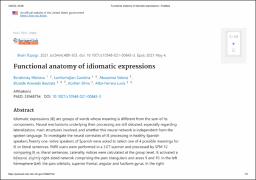| dc.description.abstract | Abstract
Idiomatic expressions (IE) are groups of words whose meaning is different from the sum of its components. Neural mechanisms underlying their processing are still debated, especially regarding lateralization, main structures involved, and whether this neural network is independent from the spoken language. To investigate the neural correlates of IE processing in healthy Spanish speakers.Twenty one native speakers of Spanish were asked to select one of 4 possible meanings for IE or literal sentences. fMRI scans were performed in a 3.0T scanner and processed by SPM 12 comparing IE vs. literal sentences. Laterality indices were calculated at the group level. IE activated a bilateral, slightly right-sided network comprising the pars triangularis and areas 9 and 10. In the left hemisphere (LH): the pars orbitalis, superior frontal, angular and fusiform gyrus. In the right hemisphere (RH): anterior insula, middle frontal, and superior temporal gyrus. This network reveals the importance of the RH, besides traditional LH areas, to comprehend IE. This agrees with the semantic coding model: the LH activates narrow semantic fields choosing one single meaning and ignoring others, and the RH detects distant semantic relationships, activating diffuse semantic fields. It is also in line with the configuration hypothesis: both meanings, literal and figurative, are executed simultaneously, until the literal meaning is definitively rejected and the figurative one is accepted. Processing IE requires the activation of fronto-temporal networks in both hemispheres. The results concur with previous studies in other languages, so these networks are independent from the spoken language. Understanding these mechanisms sheds light on IE processing difficulties in different clinical populations and must be considered when planning resective surgery.
Keywords: FMRI; Figurative; Idioms; Language; Neuroanatomy; Spanish. | es |


